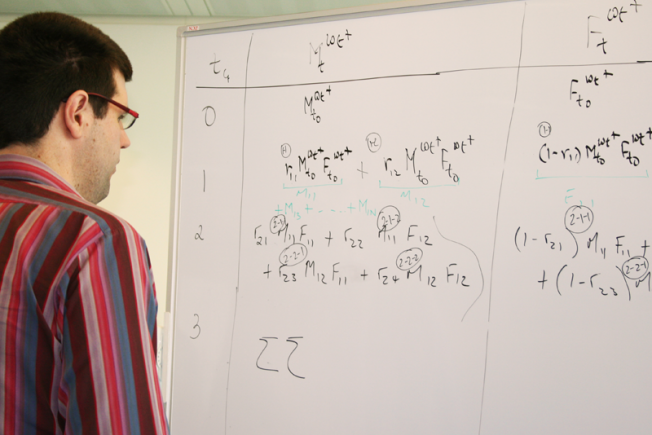Applying mathematics to 3Rs problems
At a glance
Contents

Overview
Mathematical modelling is an important tool for solving biological questions and providing new insights that can benefit science and medicine. These models provide the opportunity to vary the experimental parameters involved and to predict what effects different parameters will have on the system.
We have used different approaches to link mathematicians and biologists to provide new ways of reducing the use of animals in research and development:
- Increasing investment in mathematical modelling in toxicology
- Supporting collaboration between mathematical modellers and biologists
- Mathematical modelling and open innovation
- Accelerating acceptance of mathematical modelling in efficacy and safety decision making
Increasing investment in mathematical modelling in toxicology
We have invested £750k in a strategic funding call to address mathematical challenges which develop new, or apply existing mathematical models to toxicology research and safety testing with the aim of:
- Providing more scientifically relevant information for human and environmental safety assessment.
- Reducing reliance on animals.
The call was co-funded by the EPSRC. Four awards were made in October 2012:
- Prediction of human cardiotoxic QT prolongation using in-vitro multiple ion channel data and mathematical models of cardiac myocytes
Dr Gary Mirams, University of Oxford - Imprecision and importance: Probabilistic graphical models in toxicology
Dr Jonathan Pitchford, University of York - Uncertainty and confidence in applying mathematical models and in vitro data in toxicological safety assessments
Dr John Gosling, University of Leeds - Structural Identifiability and Indistinguishability Analysis as Tools for Quantitative and Systems Pharmacology to Support the 3Rs
Dr Michael Chappell, University of Warwick
Supporting collaboration between mathematical modellers and biologists
Maths study groups bring together mathematicians and academic and industrial researchers working within the life sciences. The biologists present research problems to a group of mathematicians who then brainstorm the problem during a week long study group. This focused approach very quickly leads to new insights to the research problems that can benefit science and the 3Rs.
2013 Maths Study Group
Working with the EPSRC-funded Maths in Medicine Study Group, we hosted the first NC3Rs Maths Study Group to solve biological problems or questions which if addressed could help to replace or reduce the use of animals. A blog by Anthony Holmes, NC3Rs ‘The power of modelling’ describes the week.
Four problems were presented. Click the titles below to download workshop reports from each contributor:
- Mathematical modelling of steroid responsiveness in severe asthma and COPD
Prof Ian Adcock, Imperial College London - Modelling heart rate changes in the mouse as a system of delayed, weakly coupled oscillators
Dr Mark Christie, King's College London - Using mathematical modelling to optimise work flow in the Sanger Mouse Genetics Project
Dr Chris Lelliott, Wellcome Trust Sanger Institute - Mathematical modelling of chronic drug infusion for toxicity assessment
Dr Dominic Williams, University of Liverpool
2014 Maths Study Group
Working with the EPSRC-funded POEMS Network (Predictive mOdelling for hEalthcare technology through MathS), and supported by the Turing Gateway to Mathematics, we hosted a study group where the focus was on solving medicine and healthcare problems to advance the 3Rs.
Five problems were presented:
Improving the utility of Drosophila melanogaster for neurodegenerative disease research by modelling courtship behaviour patterns
Birgit Bruggemeier; University of Oxford
Modelling afferent nerve responses to bladder filling
David Grundy, Richard Clayton, Donna Daly; University of Sheffield
Mathematical modelling to reduce animal use in neurodevelopmental safety assessment in humans
Richard Currie; Syngenta
Modelling the regulation of immunoglobulin class switching to IgE and IgG in human B cells to reduce animal use
David Fear, Hannah Gould; Kings College London
Understanding patterns of retinal haemorrhage
Richard Bonshek; Manchester Eye Hospital
Mathematical modelling and open innovation
We are also demonstrating the utility of mathematical modelling in our CRACK IT open innovation platform through multiple Challenges which require considerable modelling to solve.
- Virtual second species: Development of virtual dog tissues and organs for chronic toxicity studies.
- Respiratox: An in silico QSAR-based tool that reliably predicts the human respiratory irritancy potential of chemicals.
- DARTpaths: Mapping developmental and reproductive toxicity (DART) genes and pathways for cross-species comparison of toxic compound effects.
- Maximise: An in silico model to classify agrochemical mixtures to fulfil acute GHS Classification and Labelling requirements for acute oral toxicity, skin and eye irritation.
- QSARs Mix: Using existing technological data repositories to develop in silico tools to predict toxicological endpoints for substances in order to waive in vivo studies.
- VIDR: A virtual platform that models infection and the host response to pathogen assault for basic research and enhances new target development in infectious diseases.
- IVIVE: A model to provide understanding of the relevance of toxicity data from human in vitro systems to predictions of safety following relevant in vivo human exposure.
Accelerating acceptance of mathematical modelling in efficacy and safety decision making
Working with the international Health and Environmental Sciences Institute (HESI) we hosted a two day workshop in September 2016 to explore the challenges and opportunities in accelerating acceptance of evidence provided from mathematical models to improve the predictivity of efficacy and safety testing for drugs and chemicals.
The meeting brought together more than 80 scientists and regulators from across sectors and disciplines to:
- Highlight capabilities and opportunities in mathematical modelling in the biosciences;
- Hear from other industry sectors as to how mathematical modelling supports their decision making;
- Connect life scientists with mathematicians to encourage collaboration in model development;
- Define a future landscape for supporting the acceptance of mathematical modelling in safety and efficacy decision making.
Posters from the workshop
Publications
- Chernyavsky IL et al (2014) The Role of Inflammation Resolution Speed in Airway Smooth Muscle Mass Accumulation in Asthma: Insight from a Theoretical Model. PLOS One 9: e90162 doi:10.1371/journal.pone.0090162
